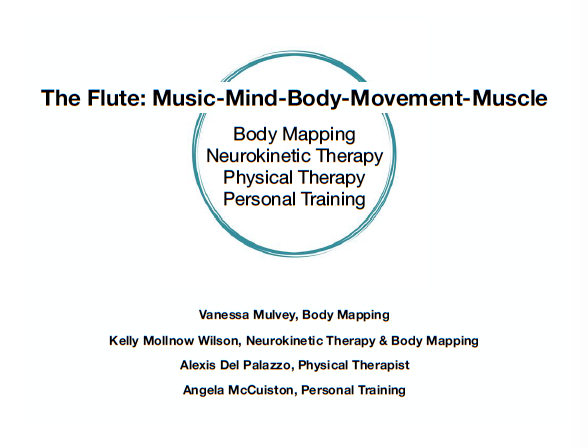If you weren’t lucky enough to attend the NFA Convention in Orlando or if you were attending another session, here is a summary of a fabulous health care panel from Sunday morning.
 The four presenters were Vanessa Mulvey (who graciously filled in for Amy Likar), Alexis Del Palazzo, Angela McCuiston and myself. We are all flutists and somatic practitioners of different disciplines. Here are the two basic themes that came up throughout the presentation. First, movement matters. All the sounds we make are produced by movement, yet we don’t often pay attention to the quality of our movement until or unless there is a problem. We have choices about how we move. Second, there are many different modalities out there in the world and if you’re having a problem, then you need to keep searching for the combination that’s going to help you get better. Everything works for somebody and nothing works for everybody.
The four presenters were Vanessa Mulvey (who graciously filled in for Amy Likar), Alexis Del Palazzo, Angela McCuiston and myself. We are all flutists and somatic practitioners of different disciplines. Here are the two basic themes that came up throughout the presentation. First, movement matters. All the sounds we make are produced by movement, yet we don’t often pay attention to the quality of our movement until or unless there is a problem. We have choices about how we move. Second, there are many different modalities out there in the world and if you’re having a problem, then you need to keep searching for the combination that’s going to help you get better. Everything works for somebody and nothing works for everybody.
Vanessa Mulvey, Boston-based Body Mapping teacher and movement coach, is on the faculties of the Longy School of Music of Bard College and the New England Conservatory. She talked about how the quality of our awareness impacts performance. Training awareness begins with observing our behavior, recognizing habits, and then choosing how to respond. To begin, she had attendees stand up and notice the feeling of their feet on the floor. Then she pointed out that people can remain aware of the floor while also listening to her voice and looking at her, using kinesthetic, aural, and visual senses. Adding in awareness of clothing on skin adds in another sense to our awareness. Many people find that they get tunnel vision when confronted with an anxious situation, such as stepping out on stage. She taught an exercise about how to find the top, bottom, and sides of our peripheral vision. Allowing more information from the periphery helps to eliminate the tunnel vision problem. For more information on Body Mapping, go to www.bodymap.org.
The second presenter was me, Kelly Mollnow Wilson. I am a Body Mapping teacher, Neurokinetic Therapist, and Licensed Massage Therapist in the Cleveland, OH area, and I teach a Body Mapping course at the Oberlin Conservatory. As a Body Mapping teacher, I found that there were some students who needed more than what I could provide as a movement teacher and Neurokinetic therapy (NKT) was the missing piece for me. NKT is a system of manual therapy that uses specific muscle tests and soft-tissue releases to engage the motor control center of the brain, rapidly restoring motion and resolving compensation patterns. The focus is on the neurological connection between your brain and a specific muscle. Can your brain fire that muscle at the right time or not? This method has nothing really to do with muscle strength. After a dysfunctional pair is found, the muscle that is overworking can be released and the muscle that is not working enough can be activated. Then the new functional pattern is practiced through corrective exercises and whole body integration. Many flutists have pain in the back of the shoulder, especially on the right side.
A common pattern that I find with flutists is a dysfunctional relationship between a muscle pulling the shoulder blade forward, which is usually overworking, and another muscle pulling the shoulder blade back, which is often underworking.
The pain is usually in the back, but the true cause of the problem is in the front. The area that hurts is often not the location of the actual problem! Go to www.neurokinetictherapy.com for more information. A few self-massage techniques were demonstrated to help with jaw tension. Finally, I briefly addressed the importance of modifying the flute to fit better into the flutist’s hands. My flute has many alterations that allowed me to return to playing after a potentially career-ending injury. Altering the instrument is not cheating!
Next up on the panel was Alexis Del Palazzo, a physical therapist on staff at Kinetic Physical Therapy, in West Chester, PA. Physical therapy addresses limitations in movement in order to reduce functional limitations and maximize participation. Physical therapists have a broad scope of practice including both orthopedics and neurology. One of the key points Alexis made was that you do not have to have a prescription to see a physical therapist. Direct Access is the ability to see a physical therapist without a referral and is available in all 50 states. Go to www.moveforeward.com for more information. Common musician injuries that physical therapists can treat include overuse injuries, such as tennis elbow, nerve entrapment conditions like thoracic outlet syndrome and carpal tunnel syndrome, muscular imbalances, and bone and joint injuries. Alexis stressed the importance of a wellness team, including a physical therapist, in recovering from injury. Alexis treats forward head posture, which involves the same pattern I described in NKT, by teaching corrective exercises such as scapular retractions and chin tucks.
Angela McCuiston is a Certified Personal Trainer through the National Academy of Sports Medicine, Corrective Exercise Specialist, and founder of Music Strong – Personal Fitness Training for Musicians. She is based in Nashville, TN. Angela got into personal training because she suffered three different injuries while she was in school and preparing for auditions.
The most important thing to understand about strength training is that proper form is mandatory.
Injuries come from not doing the exercises properly. Do not just go into a gym and start lifting weights without instruction from a knowledgable professional. The basic protocol is to release what’s tight, strengthen what is weak, and then integrate back into whole body movement. Common problems that Angela finds with flutists include pain in the neck, shoulder, back, and wrist, imbalances between chest and back, asymmetrical rotational deficiency and imbalances left to right. She went through what a possible session might be for the same pattern referenced earlier and it would contain release, stretching, mobilization, activation, and integration components. Important things to look for in a personal trainer are ongoing education, the ability to explain why a certain exercise is appropriate, and the credentials NASM-CPT CES.
Pain is your body’s request for change. Too many times, we play through and wait until we absolutely can’t play anymore until we search for help. There are people who can help you. Building a wellness team is so very important and we were glad to be able to introduce attendees to some of the current available options.
Contact Info:
Vanessa Mulvey, Body Mapping and Movement Coach
vanessa@breathemoveperform.com
www.breathemoveperform.com
Kelly Mollnow Wilson, Body Mapping and Neurokinetic Therapy
kmollnow@mac.com
www.wilsonflute.com
www.precisionperformanceandtherapy.com (coming in the near future)
Alexis Del Palazzo, Physical Therapy
adelpalazoo@gmail.com
www.kineticptpa.com
Angela McCuiston, Certified Personal Training
angela@musicstrong.com
www.MusicStrong.com

